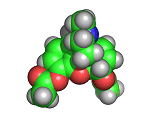Thu Sep 11 18:15:15 PDT 2008
Heroin
The molecule below is heroin. Although it looks innocuous, the addiction that heroin produces causes a great deal of suffering. Heroin is derived from the natural opiate morphine. The chemical change that creates a heroin molecule from a morphine molecule is the transformation of two -OH groups into two -CO-CH3 groups. This change leaves the heroin molecule better able to penetrate the blood brain barrier and therefore to get to the receptor sites which allow it to exert its influence.
Interestingly, by the time they interact with the receptor site, both morphine and heroin are identical. The -CO-CH3 groups are stripped off in the body and the heroin molecule reverts to being a morphine molecule.
The morphine molecule binds strongly to a receptor which would normally interact with peptide hormones. These are the molecules which your body might produce during a briefly euphoric event, such as surviving a foot race with a fearsome predator. However, this receptor was not designed to deal with a foreign molecule such as the morphine molecule and it is swamped by the presence of this molecule. Although morphine is a natural product (it is, of course, produced by poppies among other plants) it is by no means good for humans and when made even more able to cross the blood brain barrier than it natural ancestor by the addition of those -CO-CH3 groups, its affects are even more pernicious.
You can read more about drug molecules and their receptors in Docking and Blocking in The Molecular Universe site.
